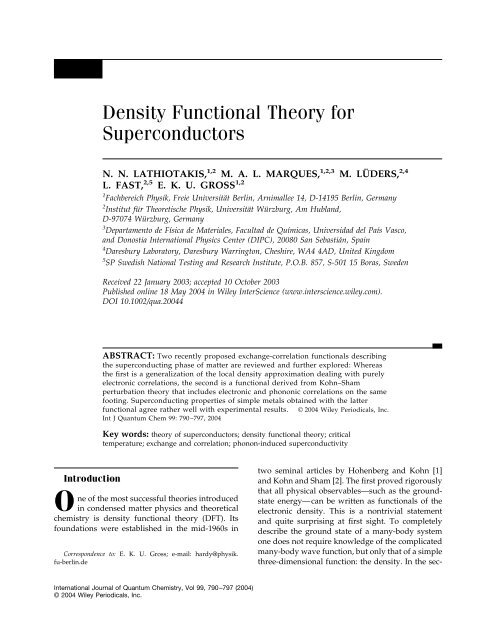Density functional theory for superconductors - Max-Planck-Institut ...
Density functional theory for superconductors - Max-Planck-Institut ...
Density functional theory for superconductors - Max-Planck-Institut ...
You also want an ePaper? Increase the reach of your titles
YUMPU automatically turns print PDFs into web optimized ePapers that Google loves.
<strong>Density</strong> Functional Theory <strong>for</strong>SuperconductorsN. N. LATHIOTAKIS, 1,2 M. A. L. MARQUES, 1,2,3 M. LÜDERS, 2,4L. FAST, 2,5 E. K. U. GROSS 1,21 Fachbereich Physik, Freie Universität Berlin, Arnimallee 14, D-14195 Berlin, Germany2 <strong>Institut</strong> für Theoretische Physik, Universität Würzburg, Am Hubland,D-97074 Würzburg, Germany3 Departamento de Física de Materiales, Facultad de Químicas, Universidad del País Vasco,and Donostia International Physics Center (DIPC), 20080 San Sebastián, Spain4 Daresbury Laboratory, Daresbury Warrington, Cheshire, WA4 4AD, United Kingdom5 SP Swedish National Testing and Research <strong>Institut</strong>e, P.O.B. 857, S-501 15 Boras, SwedenReceived 22 January 2003; accepted 10 October 2003Published online 18 May 2004 in Wiley InterScience (www.interscience.wiley.com).DOI 10.1002/qua.20044ABSTRACT: Two recently proposed exchange-correlation <strong>functional</strong>s describingthe superconducting phase of matter are reviewed and further explored: Whereasthe first is a generalization of the local density approximation dealing with purelyelectronic correlations, the second is a <strong>functional</strong> derived from Kohn–Shamperturbation <strong>theory</strong> that includes electronic and phononic correlations on the samefooting. Superconducting properties of simple metals obtained with the latter<strong>functional</strong> agree rather well with experimental results. © 2004 Wiley Periodicals, Inc.Int J Quantum Chem 99: 790–797, 2004Key words: <strong>theory</strong> of <strong>superconductors</strong>; density <strong>functional</strong> <strong>theory</strong>; criticaltemperature; exchange and correlation; phonon-induced superconductivityIntroductionOne of the most successful theories introducedin condensed matter physics and theoreticalchemistry is density <strong>functional</strong> <strong>theory</strong> (DFT). Itsfoundations were established in the mid-1960s inCorrespondence to: E. K. U. Gross; e-mail: hardy@physik.fu-berlin.detwo seminal articles by Hohenberg and Kohn [1]and Kohn and Sham [2]. The first proved rigorouslythat all physical observables—such as the groundstateenergy—can be written as <strong>functional</strong>s of theelectronic density. This is a nontrivial statementand quite surprising at first sight. To completelydescribe the ground state of a many-body systemone does not require knowledge of the complicatedmany-body wave function, but only that of a simplethree-dimensional function: the density. In the sec-International Journal of Quantum Chemistry, Vol 99, 790–797 (2004)© 2004 Wiley Periodicals, Inc.
DFT FOR SUPERCONDUCTORSond article, Kohn and Sham introduced a scheme toobtain the density from the solution of a fictitiousnoninteracting electronic system. These noninteractingelectrons move in a local potential that includes,apart from the external field, the classicalelectrostatic interaction, and an exchange and correlation(xc) term that accounts <strong>for</strong> all the manybodyeffects. To approximate the latter quantity,they proposed the famous local density approximation(LDA). Despite its simplicity, the LDA per<strong>for</strong>msremarkably well in a huge variety of molecularand solid-state systems. Over the next threedecades, several other xc <strong>functional</strong>s were proposedin the literature. Today, with the most moderngeneralized gradient approximations (GGA) ororbital <strong>functional</strong>s, DFT can compete with the computationallymuch more intensive quantum-chemistrymethods, and is the method of choice <strong>for</strong> largesystems.Un<strong>for</strong>tunately, not all physical properties can beeasily written as <strong>functional</strong>s of the ground-statedensity—e.g., excitation energies or properties ofthe superconducting state. Several extensions of thebasic <strong>theory</strong> have been put <strong>for</strong>ward to remedy thisinconvenience. In this article, we describe somerecent advances of one of those extensions, namely,DFT <strong>for</strong> <strong>superconductors</strong> (SCDFT). The basic Hohenberg–Kohnand Kohn–Sham theorems of SCDFTwere proved by Oliveira, Gross, and Kohn in thelate 1980s [3]. However, very few applications ofthe <strong>theory</strong> have appeared in the literature [4], primarilybecause of the lack of reliable xc <strong>functional</strong>s.The first attempt to construct such a <strong>functional</strong>was a generalization of the LDA to the superconductingcase [5]. This <strong>functional</strong> only accounts <strong>for</strong>the purely electronic correlations in <strong>superconductors</strong>and is based on the xc energy of a uni<strong>for</strong>melectron gas made superconducting by an externalpairing field. To calculate the latter quantity, theauthors proposed the use of Kohn–Sham perturbation<strong>theory</strong> at the level of a random-phase approximation(RPA) [6]. Recently, a new <strong>functional</strong> incorporatingboth the electron–electron and electron–phonon interactions was obtained [7] by using amethod resembling the optimized effective potentialmethod. The superconducting transition temperaturesand the gaps at zero temperature, calculated<strong>for</strong> simple metals within this <strong>for</strong>malism, turnout to agree well with experiment.In our opinion, SCDFT has now attained a levelof maturity that allows it to compete with the traditionalmany-body approaches [8, 9, 10]. Its twomain advantages are the relative simplicity of theSCDFT equations, and the nonexistence of anysemiphenomenological parameter such as the * ofEliashberg <strong>theory</strong> [9].This article is structured as follows: In the nextsection we provide a succinct description of SCDFTpresenting the basic equations of the <strong>theory</strong>. Wethen describe the construction of xc <strong>functional</strong>s <strong>for</strong><strong>superconductors</strong>. First, we present the LDA <strong>functional</strong>of Ref. [5]. To visualise this <strong>functional</strong>, theanomalous Hartree and the xc energies of the uni<strong>for</strong>msuperconducting electron gas are evaluated<strong>for</strong> a variety of order parameters. In the last section,we describe the calculation of material-specificproperties of <strong>superconductors</strong>, using the <strong>functional</strong>of Ref. [7]. We conclude with a brief outlook.DFT <strong>for</strong> SuperconductorsWe will begin with a brief overview of the SCDFTequations. This generalization of normal DFT tostudy superconductivity uses two densities: thenormal electronic densitynr ˆ rˆ r, (1)†and the “anomalous” densityr, r ˆ 1rˆ 2r, (2)which is the order parameter characterizing thesuperconducting phase. In the previous expressions,the field operator ˆ (r) annihilates an electronof spin ( 1, 2) at the position r. Withthese densities, a Hohenberg–Kohn theorem is easilyestablished [3] by generalizing Mermin’s arguments[11] <strong>for</strong> DFT at finite temperature. The theoremstates that there is a one-to-one correspondencebetween the pair of external potentials {v , }and the pair of equilibrium densities {n, }. (r, r)represents an external pairing field while v(r), as inordinary DFT, is a local potential, and is thechemical potential. The thermodynamic potential,as well as all other observables, can thus be writtenas a <strong>functional</strong> of {n, }. The next step is the constructionof a noninteracting Kohn–Sham HamiltonianINTERNATIONAL JOURNAL OF QUANTUM CHEMISTRY 791
LATHIOTAKIS ET AL. d3Ĥ s rˆ r 2† 2 v sr sThe xc potentials are defined as <strong>functional</strong> derivativesof the xc free energy <strong>functional</strong>, F xc ,ˆ rr, r H r, r r r . (8) Eliashberg equations. This similarity allows us tointerpret the quantity K ij /(1 Z i ) as an effective r d3 d3 r* s r, rˆ 1rˆ 2r H.c. . (3)v xc n, r F xcn, nr(9)Atomic units are used throughout in all equations. xc n, r, r F xcn, *r, r . The Kohn–Sham electrons are subject to an effective(10)local potential, v s (r), and to an effective pair potential, s (r, r), chosen in such a way that the densitiesIn principle, these potentials include all many-bodyof the Kohn–Sham system equal the densities of theeffects induced by electron–electron and electron–interacting system. Diagonalizing this Hamiltonianphonon interactions. The <strong>functional</strong> dependence ofleads to the Bogoliubov–de Gennes-type equationsF xc on the densities can be extremely complicatedand has to be approximated in any practical applicationof the <strong>theory</strong>. 22 v To simplify the previous equations we introducesr su i r d3 r s r, rv i rthe so-called decoupling approximation [12] <strong>for</strong> u iand v i E i u i ru 22 v sr sv i r i r u i i r, v i r v i i r, (11)d3 r* s r, ru i rwhere i are solutions of the normal-state Kohn– E i v i r, (4) Sham equation. The eigenvalues of Eq. (4) are thengiven by E i 2 i i 2 , with i i s , and iwhere u i and v i are the electron and hole amplitudes,and the Kohn–Sham potentials are defined as i . The solution of the normal-state Kohn–Shamare the Kohn–Sham eigenvalues corresponding toequation can be achieved using standard bandstructurev s n, r v 0 r v H nr v xc n, r (5)methods. Finally, i is defined as s n, r, r 0 r, r H r, r i d3 r d3 r* i r s r, r i r. (12) xc n, r, r. (6)v 0 (r) represents the external Coulomb potential The decoupling approximation reduces the problemgenerated by the periodic lattice of the ions, whileto the solution of a BCS-like gap equation 0 (r, r) usually vanishes unless there is an externalpairing field produced by the proximity of an adjacentsuperconductor. In these expressions, and intanhthe following, the square brackets indicate a <strong>functional</strong>dependence. Note that the xc potentials v j i Z i s i 1 2j E K2 E ij s j , (13)jxcand xc are <strong>functional</strong>s of both the normal and theanomalous density, whereas the Hartree potentials, where is the inverse temperature. The kernel ofv H and H , depend only on one density and are the gap equation is divided into two parts: a purelydefined asdiagonal term, Z i , and a nondiagonal part, K ij , bothbeing <strong>functional</strong>s of the Kohn–Sham pairing potentialnrv H nr d3 rr r , (7)s . This equation has the same structure as theBCS gap equation, with the K ij kernel playing therole of the model interaction kernel and Z i playinga role similar to the renormalization term in the792 VOL. 99, NO. 5
LATHIOTAKIS ET AL.FIGURE 1. Energies vs <strong>for</strong> an s-wave pair-potential with 1 (left panel) and energies vs <strong>for</strong> a pair-potentialwith 0.01 (right panel). Both panels were calculated <strong>for</strong> r s 1 and T 0K.the <strong>functional</strong> <strong>for</strong> an s-wave pairing potential havingthe shape of a Gaussian s k s exp k/k F 1 2 2 (20)where k F is the Fermi momentum, and and aredimensionless parameters. To gain some insightinto the relative importance of the anomalous Hartreeenergy [the energy term associated with theanomalous Hartree potential (8)]f AH 4 31 d3 k d3 k 4 k k2 2 3 k k 2 E k E kthis calculation was set to zero. The dependence ofthe energies on the parameters and turns out tobe rather smooth. The largest positive contributioncomes from the anomalous Hartree term, and isalmost canceled by the RPA correlation energy difference( f RPA f NRPA ). The exchange part is positive,Sbut much smaller (almost an order of magnitude)than the other two terms. The sum of the three ispositive everywhere. The same statement holdstrue <strong>for</strong> 0.01 100 1, 0.01 1, and r s 0.1, 1, 2, 3, 4, 5. In the conventional s-wave <strong>superconductors</strong>,the pairing mechanism is phononic,and the above Coulombic positive-energy contributionsreduce superconductivity. tanh 2 E ktanh 2 E k, (21)versus the exchange and the RPA contributions, wecalculated these quantities numerically <strong>for</strong> a widerange of parameters.The results are summarized in Figure 1, wherewe plot the difference of exchange energies, f S x f N x ,in the superconducting (S) and normal (N) states;Sthe negative difference ( f RPA f NRPA ) of the correspondingRPA correlation energies; the anomalousHartree energy, f AH and the sum, f cond , of thesethree terms representing the potential part of thecondensation energy. In the left panel of Figure 1these energies are plotted versus the parameter <strong>for</strong> 1, and in the right panel the same quantitiesare plotted as functions of <strong>for</strong> 0.01. These twoplots were obtained <strong>for</strong> r s 1. The temperature inPhonon-Induced SuperconductivityFor a proper description of real materials, boththe electron–phonon and electron–electron interactionshave to be included. A suitable xc <strong>functional</strong>has been constructed via Kohn–Sham perturbation<strong>theory</strong> taken to the second order in powers ofe, the electron charge, and g, the electron–phononcoupling constant. The resulting gap equationwas then simplified by taking the values of K ijand Z i at 0. Two terms were found to contributeto the kernel K ij , the first of phononicorigin, K ph ij , and the second of electronic origin,el . They can be written asK ijK el ij w ij ,794 VOL. 99, NO. 5
K ph ij 2tanh 2 itanh 2 j qg ij q 2DFT FOR SUPERCONDUCTORSpolarization and wave-vector, respectively. Thefunction I is defined as I i , j , q I i , j , q (22)where w ij is the matrix element of the Coulombinteractionw ij ijg qd3rd31r* i r i rr r j* r j r. (23)is the electron–phonon coupling constant, qthe phonon frequency, and and q are the phononI i , j , q f i f j n q e jq e iqei ej (24) i j q i j q,where f and n are the Fermi–Dirac and the Bose–Einstein distribution functions, respectively.Similarly, two terms contribute to Z i ,Z i el 12 ijw ij1 tanh 2 j ¥ jk2 w jkcosh 2 2 j 1 tanh 2 k2¥ jcosh 2 2 j(25)Z i ph 2tanh 2 i j g ij q 2 I i , j , q , (26)qwhere I is the derivative of I with respect to its firstargument.It is a demanding numerical task to obtain thegap as a function of k, <strong>for</strong> it involves the solution ofa three-dimensional integral equation. This is requiredif one wants to study the angular anisotropyof the gap, or if the Fermi surface of the material ishighly nonspherical. However, <strong>for</strong> the simple systemswe consider in this work, the calculations canbe simplified by approximating the electronic eigenspectrumwith a free-electron parabola, and byassuming the electron–phonon coupling constant tobe independent of k. These approximations allowus to convert the three-dimensional gap equationinto a one-dimensional integral equation by changingthe variable of integration from wave-vector toenergy. In addition, to take into account screeningeffects, we replaced the bare Coulomb interactionby a Thomas–Fermi function.To solve numerically the nonlinear gap equation(13) <strong>for</strong> different temperatures, we iterate it untilconvergence is achieved. No more than a few hundrediterations were necessary, which correspondsto a few minutes of computer time <strong>for</strong> every giventemperature. In Figure 2, we show typical solutionsof the gap equation at 0.01 K <strong>for</strong> two differentmetals, tantalum and aluminum. In the same figurewe show the dependence of the gap at the Fermienergy, 0 , on the temperature.To find the precise value of the critical temperature,T c , we followed a simpler and numericallymore stable procedure: The gap equation was linearizedin and converted into an eigenvalue problemby introducing the “eigenvalue” i M ij j , (27)jwhere i denotes the mesh index, and M is definedasM ij 1 K ij 02 1 Z i 0tanh i2 i. (28)In this way, T c is identified as the temperature <strong>for</strong>which the largest eigenvalue max () is equal toINTERNATIONAL JOURNAL OF QUANTUM CHEMISTRY 795
LATHIOTAKIS ET AL.FIGURE 2. Temperature dependence of the gap function at the Fermi energy, 0 , and the gap vs energy at zerotemperature <strong>for</strong> tantalum (upper panels) and aluminum (lower panels).one. As we are only interested in the dominanteigenvalue of M, we simply iterate Eq. (27) untilself-consistency is reached. It is then simple toprove that max ¥ j M ij j i . (29)The equation () 1 is then solved by a simplebisection algorithm.Our findings <strong>for</strong> T c and 0 are shown in Table I.The electron–phonon coupling constants, g q , usedto obtain these results were calculated from firstprinciples in Ref. [15]. Given that both T c and 0depend extremely sensitively on the electron–phononcoupling constants, the agreement between thecalculated values and the experiment is remarkablygood. Both T c and 0 are overestimated <strong>for</strong> vanadium,an expected result due to the strong spinfluctuations existing in this material, which ourpresent <strong>functional</strong> does not take into account. Thesmall values of T c and 0 <strong>for</strong> aluminum and mo-TABLE I ______________________________________Computed transition temperatures (in K) andsuperconducting gaps at zero temperature (in meV)<strong>for</strong> simple metals compared with experimentalvalues from Ref. [14].T c (DFT) T c (exp.) 0 (DFT) 0 (exp)Al 0.76 1.18 0.117 0.179Nb 9.37 9.5 1.69 1.55Mo 0.65 0.92 0.099 —Ta 4.51 4.48 0.764 0.694V 16.3 5.38 2.99 0.789Pb 6.58 7.2 1.24 1.33Cu 0.01 — — —796 VOL. 99, NO. 5
DFT FOR SUPERCONDUCTORSlybdenum, on the other hand, indicate a systematicunderestimation of the phononic part of the kernel,K ij ph , <strong>for</strong> small temperatures. We emphasize thatthere are no phenomenological parameters involvedin the calculation. All quantities are calculatedfrom first principles. The results represent thefirst fully ab initio calculations of material-specificproperties of <strong>superconductors</strong>. The rather goodagreement with experiment is certainly encouraging.The next step toward the description of morecomplex <strong>superconductors</strong>, with band structures deviatingstrongly from spherical symmetry, will bethe implementation of the three-dimensional gapequation.References1. Hohenberg, P.; Kohn, W. Phys Rev 1964, 136, B864.2. Kohn, W.; Sham, L. J. Phys Rev 1965, 140, A1133.3. Oliveira, L. N.; Gross, E. K. U.; Kohn, W. Phys Rev Lett 1988,60, 2430.4. Suvasini, M. B.; Gyorffy, B. L. Physica C 1992, 195, 109;Suvasini, M. B.; Temmerman, W. M.; Gyorffy, B. L. Phys RevB 1993, 48, 1202; Gyorffy, B. L.; Szotek, Z.; Temmerman,W. M.; Andersen, O. K.; Jepsen, O. Phys Rev B 1998, 58, 1025;Temmerman, W. M.; Szotek, Z.; Gyorffy, B. L.; Andersen,O. K.; Jepsen, O. Phys Rev Lett 1996, 76, 307.5. Kurth, S.; Marques, M.; Lüders, M.; Gross, E. K. U. Phys RevLett 1999, 83, 2628.6. Gell-Mann, M.; Brueckner, K. A. Phys Rev 1957, 106, 364.7. Marques, M. A. L.; Lüders, M.; Lathiotakis, N. N.; Fast, L.;Floris, A.; Continenza, A.; Profeta, G.; Massidda, S.; Gross,E. K. U., submitted to Phys Rev B, 2004.8. Bardeen, J.; Cooper, L. N.; Schrieffer, J. R. Phys Rev 1957,108, 1175.9. Eliashberg, G. M.; Sov Phys JETP 1960, 11, 696; Scalapino,D. J. In Superconductivity; Marcel Dekker: New York, 1969;Vol 1, p 449; Allen, P. B.; Mitrovic, B. In Solid State Physics;Seitz, F., Ed.; Academic Press: New York, 1982; Vol 37, p 1;Rainer, D. In Progress in Low Temperature Physics; Brewer,D. F., Ed.; North-Holland: Amsterdam, 1986; Vol X, p 371.10. Nambu, Y. Phys Rev 1960, 117, 648.11. Mermin, N. D. Phys Rev 1965, 137, A1441.12. Gross, E. K. U.; Kurth, S. Int J Quant Chem Symp 1991, 25,289.13. Ullrich, C. A.; Gross, E. K. U. Aust J Phys 1995, 49, 103.14. Ashcroft, N. W.; Mermin, N. D. Solid State Physics; (SaundersCollege Publishing: Fort Worth, TX, 1976).15. Savrasov, S. Y. Phys Rev Lett 1992, 69, 2819; Savrasov, S. Y.;Savrasov, D. Y. Phys Rev B 1996, 54, 16487.INTERNATIONAL JOURNAL OF QUANTUM CHEMISTRY 797




